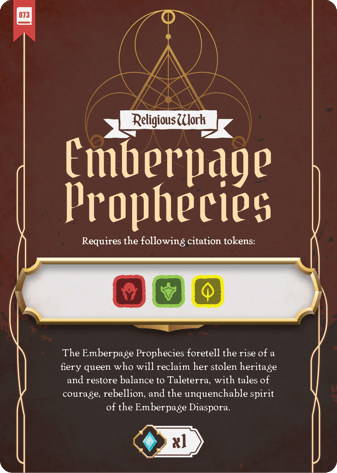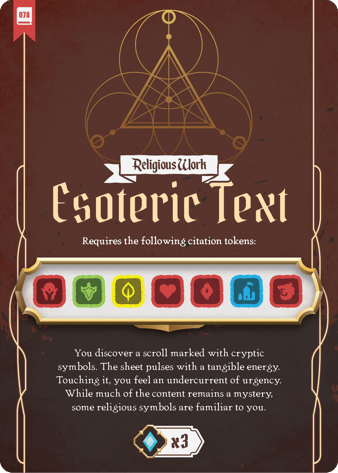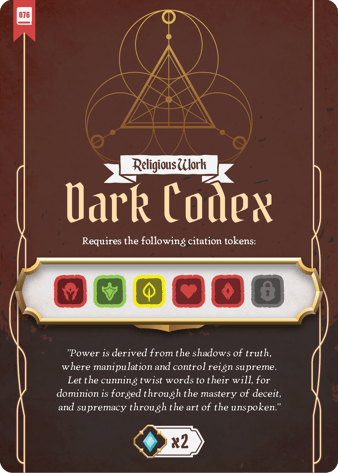
Bible & Other Religious Writings
In the sanctified halls of the Grand Archive, wisdom flows not only through the ink of scholars but through the very fabric of existence—etched upon ancient runestones, inscribed in celestial tablets, and whispered through the veil of the divine. These sacred writings stand as eternal testaments to cosmic law, containing prophecies, doctrines, and hymns sung by the celestial choirs themselves. Whether bestowed upon mortal scribes by ethereal messengers, recorded in the dream-visions of mystics, or preserved in gold-leafed tomes locked within temple vaults, these works guide both the devout and the arcane seeker alike. Here, we present a curated collection of revered texts, enchanted psalms, and divine revelations, each an echo of ancient pacts and celestial wisdom.
Unlike traditional books and journal articles, religious writings often require special citation elements, including:
Sacred authors, prophets, or divine scribes instead of conventional authors.
Passage divisions such as verses, chapters, scrolls, or tablets instead of page numbers.
Translation versions or commentaries, specifying different interpretations.
Ethereal repositories, ancient archives, or scripture councils as sources.
Below, you will find examples of various religious writings, cited in different styles to illustrate their variance in academic writing.
Hymnal Texts
Sacred hymns, much like echoed prayers from the divine realm, provide mystical guidance and poetic revelations. These texts often require the name of the deity, celestial author, or divine order that transcribed them.
Example (Harvard Style): Elyndor, S. (Year 700, Starfall Era). The Celestial Hymns of Aurelion. Trans. Luminaris, T. Elderscribe Press.
Sacred Codices
Ancient religious codices serve as guiding scriptures for enchanted faiths, detailing laws, visions, and mythic origins. These citations require the sacred text name, chapter, and verse, along with translation details.
Example (APA 7th Edition): Council of Verdant Sages. (Year 402). The Book of the Verdant Covenant (3rd ed.). Moonroot Translations.
Oracular texts
Prophecies, often recorded on starlit scrolls or dream-etched tablets, foretell the fates of realms and the rise of chosen ones. These texts, dictated by oracles, visionaries, and celestial guides, must be cited with both the prophecy’s name and its seer’s recorded vision date.
Example (MLA): Silver Oracle, E. The Prophecies of the Silver Oracle. Vision Scrolls of the Astral Plane, Year 1150, https://astralprophecies.sages. Accessed Twilight 6, 1152.
Holy Scriptures
Like the light of twin suns rising over an ancient temple, holy scriptures provide guidance, doctrine, and celestial wisdom. Their verses are meticulously preserved and interpreted by councils of scholars, ensuring that each word remains unaltered through time.
Example (Chicago Style): Eldertome Canon. 986. The Gospel of the Twin Suns, 14:3-7. Translated by The High Council of Radiance. Elderscribe Archives.
Mystic Scrolls
Sacred scrolls, often infused with lunar ink and celestial sigils, are considered divine whispers set to parchment. These writings, unrolled only in times of great need, contain prophetic verses and guidance for seekers of higher truths.
Example (Vancouver Style): Elune, H. The Lunar Scrolls of Elune [Sacred Codex]. Starlit Canon Archives; Year 870.
Testaments of the Divine
Testaments serve as binding covenants between the mortal and divine realms, outlining laws, decrees, and trials of the faithful. Transcribed by scribes of the highest order, these documents chronicle the unfolding of celestial will.
Example (IEEE Style): I. Dawncaller, The Testament of the Astral Heralds. Transcribed by E. Starborn. Ethereal Scriptorium, Year 1320.
Runestone Inscriptions
Carved into living stone with enchanted chisels, these inscriptions remain unaltered by time. Found in ancient ruins, holy sanctuaries, or celestial shrines, they serve as both warnings and revelations.
Example (Turabian Style): High Priestess Moonshade, ed. The Runestone Commandments of the Dawnforged. Engraved in the Sanctum of Solace, Year 401.
Sacred Psalms
The echoes of divine canticles, once sung by angelic choirs, are preserved in written psalms. These texts serve as a bridge between music and scripture, their verses often recited in sacred ceremonies or inscribed upon temple walls.
Example (APA 6th Edition): High Cantor Aurelius. (Year 1356). The Psalms of the Eternal Choir. Echoed Hymns Press.
Ritual Manuscripts
These manuscripts are more than mere scripture—they detail sacred rites, spells of divine invocation, and celestial summoning ceremonies. Guarded in forbidden vaults and monastery libraries, their wisdom is granted only to those deemed worthy.
Example (Harvard Style): Order of the Eternal Dawn. (Year 1452). The Book of Sacred Rites [Enchanted Manuscript]. Sunblessed Scriptorium.
Concordances of Faith
The Divine Concordance is a vast index of celestial knowledge, compiled over centuries by devoted scholars and temple archivists. It serves as a roadmap through the layered wisdom of sacred texts, ensuring that no verse is lost to time.
Example (Chicago Style): Grand Archivist Lunaria, ed. The Divine Concordance of the High Sages. Eldertome Press, Year 1599.
Religious writings are more than just scripted words—they are living testaments of faith, prophecy, and divine knowledge. By properly citing sacred codices, enchanted psalms, and prophetic scrolls, scholars ensure that these wisdoms endure for future generations of truth-seekers. Whether whispered by celestial messengers, engraved upon runestones, or sung by divine choirs, each sacred text must be documented with reverence and scholarly diligence. The Grand Archive stands ever watchful, preserving the sacred for those who seek enlightenment.







